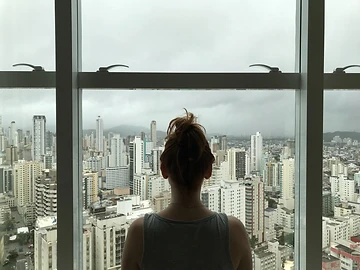More and more people are
learning about the pollution problems currently plaguing Korea. They want to
know what they can bring, or prepare before coming. Hopefully, I can provide a
few ideas.
I divide the inquisitive
into two groups of people: Those who will live on a US Army base, and those who
will live in a Korean home.
D.O.D. / US Service Members on a Base
If you will be living in
a US Army base, you'll likely be living in a 110-volt energy world, like back
home, but you should try to find out. You might even have 220v plugs, in
addition to the 110v outlets.
 |
| USA style 110 volt mains power outlet |
I have never been there,
but I am told the PX sells "Blue" brand air purifiers. Do your
research as to the size they cover, and how many you may need for your home. I
do not believe the models they sell have onboard digital PM2.5 meters, but I am
not able to see updates as to the product they carry, to be sure. If they do
not, then please consider purchasing an air monitor ($40+) to track the air
quality in your home. See this post for more
information. You might also order an air purifier like a Winix 5300 or 5500
from Amazon. These are great models for up to an 11-pyung space, such as a
large bedroom or small living room. They have useful features, but they lack digital
displays for PM2.5 dust. Oddly, you can purchase these 110v Winix models more
inexpensively than Korea, but shipping may bring prices closer to equal what
Koreans pay for 220v purifiers. It's up to you, but you might want to have one
ready, or bring one with you when you arrive. You can always add more later.
The larger 110v purifiers are a mixed bag of overpriced units, and many small
units that make grandiose claims about room sizes they clean. The purifiers in
the USA tend toward two markets: allergy sufferers and smokers. Avoid the
"ionizer" types, which have no HEPA filter, as they're really meant
for smokers, and may spew dangerous ozone, anyway. Korean stores will sell
larger air purifiers at prices that are a better value. Not inexpensive -- but
cheaper than you'll pay for a large air purifier from home, so if you also have
220v outlets, you will want to buy from here.
All Others Living in Korean Homes
If you are living in a
Korean home, you will find 220v power from the power mains outlets in every
case. Don't bother bringing an air purifier, as you'll waste money and space to
bring it with you, and you'll need a converter (which will cost, and waste
energy).
 |
| 220v Korean Plug |
Just buy a purifier when
you get here. Know that, in most instances, you'll find much better prices
online. Some models may only be cheaper at Hi-Mart or E-mart if they are the
main distributor (Coway and Dyson are currently two examples), or if there is a
special sale. You might want to learn the English side of using Korean websites
like Coupang and Gmarket. Unfortunately, many of the other good sites lack any
English at all. Even with the English sites, you may need help registering, and
will likely need an address when you finally do. But, you can still look at it
and see prices. Also, it never hurts to ask if your new boss will be providing
an air purifier as part of the appliances in your home. It's rare, but it does
happen for a lucky few.
Everyone Can Buy Masks In Advance
If you are coming from
overseas, you can buy a few masks to have handy, until you find how to get them
here. See my blog about various masks, or go ahead and purchase some from
Amazon to bring with you. A popular adult mask that I love is the 3M 9322K,
but they sell under a different model number in other countries. In the USA, these are sold as the 3M 9211. A side note -- 3M also sells the 9210K (N95) and 9310K (N80) at quite a bit less, but without the valve. The 9310K is one of my favorite all-time masks, and I use it to exercise in. These cheaper non-valve masks are indentical to the valved versions in all other ways.
At left is the 9322K. They are a bit industrial
looking, but they are EXCELLENT masks. They are rated as KN94/N95, but they
have been independently tested to filter up to 97% of dust. Comfort is posh. I
wear mine for a week, or until they become dirty, stinky, or messy. I also like
to trim the head straps and re-tie the sides for ears, but that's my personal
preference. Some cheaper masks can be very uncomfortable, or not seal well. If
a mask doesn't seal well, it's useless. Others may want to be a little more
stylish. In that case, take a look at my masks page
and my favorite masks blog post. Probably the easiest to
get quickly, after arriving, is the Dobu Mask, sold at 7/11 stores. They are
half of the price online, once you figure out how to buy there. Speaking of
children, you can find masks for kids and adults at the DAISO (dollar stores)
in Korea, but quality varies. Also, please see my post about how to protect infants and
toddlers from fine dust.
Hopefully this post has helped. Chances are you've already
started researching and trying to learn about living here. That's good. Please
read through my other blog posts to learn about subjects like airing-out the
house, mold, purifiers, air detectors, and more. Good luck!









